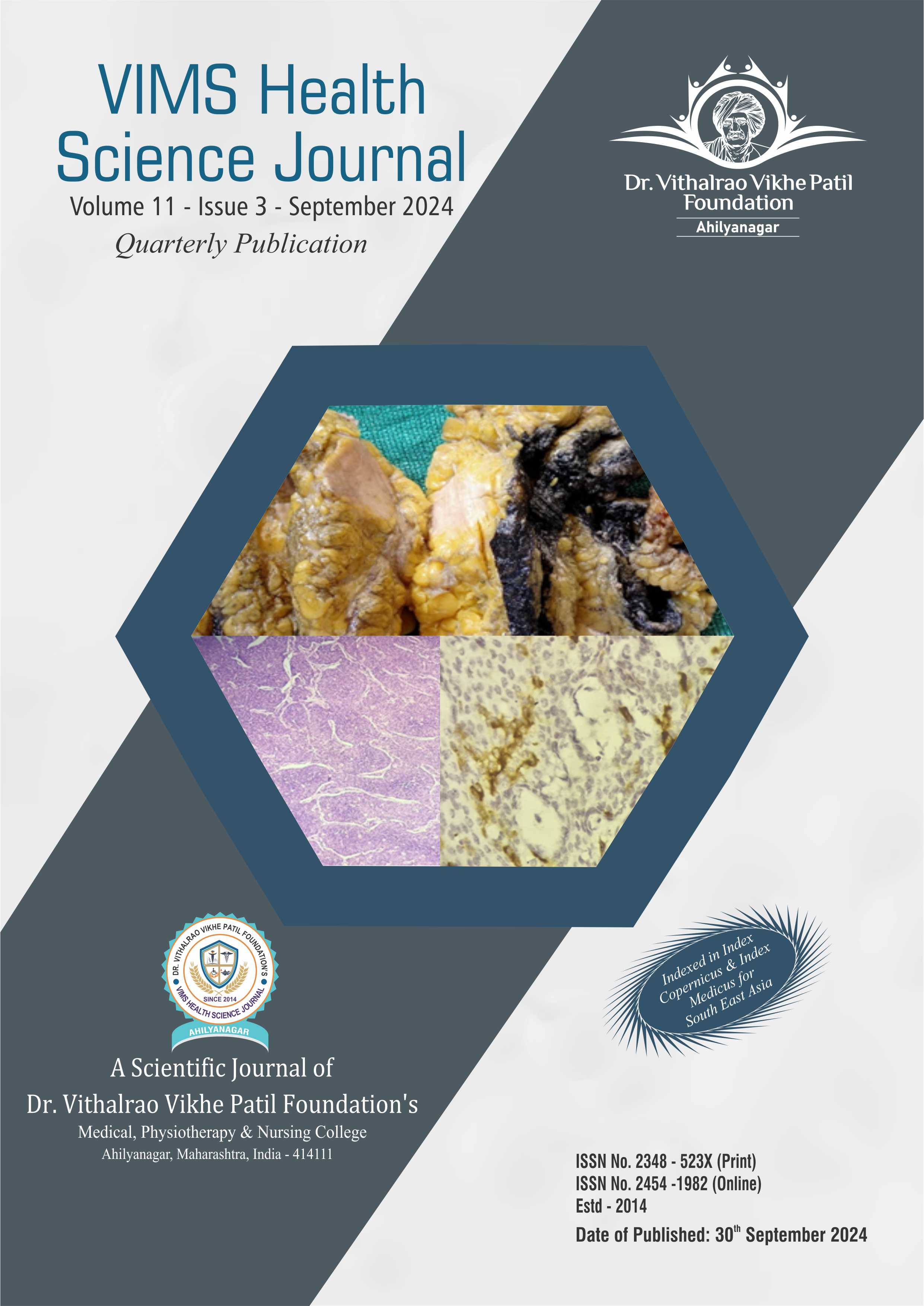The Effectiveness of EMG Biofeedback to Improve Ankle Dorsiflexion in Stroke Patients: A Systematic Review
DOI:
https://doi.org/10.46858/vimshsj.110304Keywords:
EMG biofeedback, Stroke, Ankle dorsiflexionAbstract
Background: Stroke, results in some form of residual deficits even after recovery. Patients face difficulty in ambulating, probably because of reduced ankle dorsiflexion. Present systematic review aims to explore the literature-related to studies conducted on patients with Stroke for the effectiveness of electromyography biofeedback (EMG BF) therapy in the treatment of ankle dorsiflexion. Methodology: This study included nine randomised trials, all including patients who developed stroke after an episode of acute Ischemic infract. Use of databases Google Scholar, PubMed and CINHAL full text was done. Results: EMG muscle activity also showed improvement in 3 out of 9 studies. This may be attributed to gradual weight bearing and improving in muscle activity over the period of time. Discussion: EMG BF is useful for improving motor functions and walking speed as well as increasing ROM and muscle activation maybe because new pathways are formed or previous cerebral and spinal pathways and networks are activated by the stimulation with feedback or remaining proprioceptive senses are regulated by visual and acoustic warnings. Conclusion: There is gradual weight bearing and improvement in muscle activity post EMG BFB over the period of time.
Downloads
References
Coupland AP, Thapar A, Qureshi MI, Jenkins H, Davies AH. The definition of Stroke. J R Soc Med. 2017 Jan;110(1):9–12.
Stroke epidemiology: advancing our understanding of disease mechanism and therapy - PubMed [Internet]. [cited 2022 Jul 17]. Available from: https://pubmed.ncbi.nlm.nih.gov/21691873/
WSO Global Stroke Fact Sheet 2022 [Internet]. World Stroke Organization. [cited 2022 Jul 17]. Available from: https://www.world-Stroke.org/news-and-blog/news/wso-global-Stroke-fact-sheet-2022
State of World Population 2019 [Internet]. United Nations Population Fund. [cited 2022 Jul 17]. Available from: https://www.unfpa.org/publications/state-world-population-2019
Suwanwela NC, Poungvarin N, Panel the ASA. Stroke burden and Stroke care system in Asia. Neurol India. 2016 Feb 1;64(7):46.
Intiso D, Santilli V, Grasso MG, Rossi R, Caruso I. Rehabilitation of walking with electromyographic Biofeedback in foot-drop after Stroke. Stroke. 1994 Jun;25(6):1189-92
Winter DA. Concerning the scientific basis for the diagnosis of pathological gait and for rehabilitation protocols. Physiotherapy Canada. 1985;37(4):245-52.
Dost Sürücü G, Tezen Ö. The effect of EMG biofeedback on lower extremity functions in hemiplegic patients. Acta Neurologica Belgica. 2021 Feb;121:113-8.
Tamburella F, Moreno JC, Herrera Valenzuela DS, Pisotta I, Iosa M, Cincotti F, Mattia D, Pons JL, Molinari M. Influences of the biofeedback content on robotic post-stroke gait rehabilitation: electromyographic vs joint torque biofeedback. Journal of neuroengineering and rehabilitation. 2019 Dec;16:1-7.
Bradley L, Hart BB, Mandana S, Flowers K, Riches M, Sanderson P. Electromyographic biofeedback for gait training after stroke. Clinical rehabilitation. 1998 Feb;12(1):11-22.
Jung KS, Bang H, In TS, Cho HY. Gait training with auditory feedback improves trunk control, muscle activation and dynamic balance in patients with hemiparetic stroke: A randomized controlled pilot study. Journal of Back and Musculoskeletal Rehabilitation. 2020 Jan 1;33(1):1-6.
Jonsdottir J, Cattaneo D, Recalcati M, Regola A, Rabuffetti M, Ferrarin M, Casiraghi A. Task-oriented biofeedback to improve gait in individuals with chronic stroke: motor learning approach. Neurorehabilitation and neural repair. 2010 Jun;24(5):478-85.
Gámez AB, Hernandez Morante JJ, Martínez Gil JL, Esparza F, Martínez CM. The effect of surface electromyography biofeedback on the activity of extensor and dorsiflexor muscles in elderly adults: a randomized trial. Scientific reports. 2019 Sep 11;9(1):13153.
Tamburella F, Moreno JC, Iosa M, Pisotta I, Cincotti F, Mattia D, Pons JL, Molinari M. Boosting the traditional physiotherapist approach for stroke spasticity using a sensorized ankle foot orthosis: a pilot study. Topics in stroke rehabilitation. 2017 Aug 18;24(6):447-56.
Pak NW, Lee JH. Effects of visual feedback training and visual targets on muscle activation, balancing, and walking ability in adults after hemiplegic stroke: A preliminary, randomized, controlled study. International journal of rehabilitation research. 2020 Mar 1;43(1):76-81.
Kwakkel G, Winters C, Van Wegen EE, Nijland RH, Van Kuijk AA, Visser-Meily A, De Groot J, De Vlugt E, Arendzen JH, Geurts AC, Meskers CG. Effects of unilateral upper limb training in two distinct prognostic groups early after stroke: the EXPLICIT-stroke randomized clinical trial. Neurorehabilitation and neural repair. 2016 Oct;30(9):804-16.
Meseguer-Henarejos AB, Sánchez-Meca J, López-Pina JA, Carles-Hernández R. Inter-and intra-rater reliability of the Modified Ashworth Scale: a systematic review and meta-analysis. European journal of physical and rehabilitation medicine. 2017 Sep 13;54(4):576-90.
Xie T, Leng Y, Zhi Y, Jiang C, Tian N, Luo Z, Yu H, Song R. Increased muscle activity accompanying with decreased complexity as spasticity appears: High-density EMG-based case studies on stroke patients. Frontiers in Bioengineering and Biotechnology. 2020 Nov 16;8:589321.
Lin JH, Hsueh IP, Sheu CF, Hsieh CL. Psychometric properties of the sensory scale of the Fugl-Meyer Assessment in stroke patients. Clinical rehabilitation. 2004 Jun;18(4):391-7.
Hiengkaew V, Jitaree K, Chaiyawat P. Minimal detectable changes of the Berg Balance Scale, Fugl-Meyer Assessment Scale, Timed “Up & Go” Test, gait speeds, and 2-minute walk test in individuals with chronic stroke with different degrees of ankle plantarflexor tone. Archives of physical medicine and rehabilitation. 2012 Jul 1;93(7):1201-8.
Published
How to Cite
Issue
Section
Copyright (c) 2025 Dr. Gaurav Toshniwal, Dr. Suvarna S. Ganvir, Dr. Maheshwari Harishchandre

This work is licensed under a Creative Commons Attribution-NonCommercial-ShareAlike 4.0 International License.









